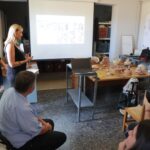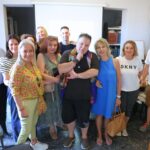

Corinthia: An enticing destination with a unique history for quality holidays

Starting from Ancient Corinth, our tour began in one of the most historic places in Greece.
Visit to Tenea at the Archaeological Service offices for a presentation of excavation findings.
Between the two villages of Chiliomodi and Kleinia lay the important city of Tenea.
According to Pausanias, its first inhabitants were of Trojan origin, captured by the Greeks on Tenedos and brought there as prisoners. Agamemnon allowed them to build homes. Virgil, on the other hand, claimed that both Tenea and Rome were founded by Trojans. According to myth, it is also the place where Polybus raised Oedipus.
The first significant find of the area is the Apollo of Tenea, or otherwise the Kouros of Tenea. The famous statue of the 6th century BC, excavated in 1854. In 2010, two more kouroi were found at a site where an extensive cemetery was revealed, crossed by an ancient road and dating to the 6th, 5th, and 4th centuries BC. Today, the two kouroi are exhibited at the Archaeological Museum of Ancient Corinth.
In the systematic excavation that began in 2013, led by Dr. Korka, an organized cemetery was identified around the 1984 burial, dating from the 6th to the 3rd century BC.
In 2018, remains of the city’s residential fabric were uncovered for the first time, with rich findings. In an area of 672 sq.m., roofed spaces with door openings were excavated, organized around internal courtyards. The archaeological research also revealed a unique for Corinthia two-chambered above-ground funerary monument dating to the 1st century AD, with its period of use extending to the 4th century AD.
This remarkable archaeological discovery was listed among the major historical and archaeological events of 2018 by the History network website.
Beyond the finds, another factor that makes this excavation unique is the relationships that developed between the local community and the members of the research team, leading to the creation of the “Friends of Ancient Tenea” association. A society that played a crucial role in the success of the entire program.
Stephanion Observatory
The observatory was founded in 1967 in Stefani, Corinthia, on the “Dragatoura” hill, following the interest of foreign scientists and the active support of local residents.
This observatory (Stephanion Observatory) is the first modern observatory in Greece. Between 1967 and 1973, many rising scientists passed through Stefani, who later became world-renowned astronomers, such as the Dutch Jan van Paradijs, a NASA researcher and one of the top astrophysicists in the world.
The first modern telescope in Greece and one of the largest of its time in Europe, the 30-inch reflecting telescope, was installed on 25.06.1971 in a shelter at the site, charting a new course for the Stephanion Observatory and for Greek astronomy in general.
The Cultural and Educational Association of Stefani, in collaboration with the Astronomy Group of the KEPAK of the Municipality of Corinth, frequently organizes Astronomy nights and parallel events at the Stephanion Observatory.
Lunch at the traditional tavern “Velanidia” in Stefani, Corinthia
A gastronomic paradise for food lovers. For those who appreciate good grilled meat, an outing to Stefani, Corinthia, and specifically to the tavern Velanidia, is a unique culinary experience!
Local meats, friendly service, generous portions, homemade bread baked in a stone oven served with local olive oil and oregano, marinated wild boar chops, meatballs in two delicious versions (lamb and ewe), as well as huge juicy beef steaks.
Dinner at KAZE
A unique experience of a summer escape from the urban landscape, at the most seaside point of the city.
The new vibe that KAZE brings to the Kalamia beach of Corinth runs through its entire operation and is reflected in the service, design, and menu.
With a design inspired by the natural environment, it welcomes you warmly throughout the day, making it the ideal destination to enjoy refreshing cocktails and selected gastronomic options by the sea.
Traditional breakfast in the village of Solomos, Corinthia at “Pietris” Bakery – Tasting of local delicacies
Almost five decades have passed since two self-made men decided to create the first wood-fired oven on the ground floor of their house in Solomos, Corinthia.
Today the third generation, faithful to the technique of bread-making (the sourdough loaf of Solomos), has managed both to preserve the store in Solomos and to expand, developing new activities in Attica and Corinthia.
From 1995 to today, the name Pietris became a “brand name” in the production of bakery and pastry products, continuing the tradition while keeping up with modern technology and organization. Day by day, with much effort and persistence, the family bakery grew into a bakery industry, acquiring its current legal name “Hellenic Bakery” and based in Corinth near the Isthmus.
Visit to the Ancient Port of Lechaion
The port of Lechaion was the main harbor – seaport of Ancient Corinth, a marvel of know-how and technology, first imitated by the Carthaginians and later by the Romans. It was named after Leches, son of Peirene and Poseidon. It is located on the Corinthian Gulf and was connected to the city of Corinth with long walls, a total length of 2,300 m. Between the walls lay the famous Lechaion road.
The port, which had two sections, the commercial and the naval station, was entirely artificial. It had three inner harbor basins and three outer ports. The excavated earth was heaped into two mounds, ensuring protection of the inner basins from the strong northern winds, which still exist today.
Along the ports, stone piers, moles, breakwaters, ramps were constructed, with a total length of 7 km, as well as a large number of warehouses and other port facilities for the thousands of tons of goods to and from the colonies of Corinth, and in the southwest a huge number of shipbuilding facilities, where triremes were built on behalf of other city-states, creating the first naval war industry, resembling that of today.
“The Lechaion Harbor and Settlement Land” Project
The general goals of the Lechaion Harbor and Settlement Land Project aim to document and preserve the site of Lechaion in order to:
- improve our understanding of the chronology of occupation at the port,
- document Greek and Roman harbor design on site,
- test theories of Roman colonial foundation practices,
- better understand the economic structures of diachronic trade in a Mediterranean maritime hub, and
- further improve our understanding of the destruction and abandonment of the site to identify environmental and social pressures that outweighed the need and usefulness of occupying one of antiquity’s most strategically located ports.
The excavation is conducted in 4 areas: AREA A, B, C, D.
The excavation of Area A will contribute to refining the chronology and occupation of the site, as most of our older finds (Mycenaean, Geometric, and Proto-Corinthian) come from within and around this building.
In this area, a human skeleton was uncovered, apparently a woman in her 20s. This is remarkable for several reasons. First, it does not appear to be a tomb but rather that she was crushed during the collapse of the building’s roof. Her chest was broken, her left arm raised apparently to her face, and her right arm behind her. So far, the lower part of her body has not been found. From the pelvis down she is missing. If she was indeed crushed by the collapsing roof, this may confirm that an earthquake in the late 5th century AD led to the abandonment of the harbor.
The ongoing excavation is critical and necessary not only because we are excavating a settlement now known to include fortification walls and a large circular building (Mausoleum – Area D, where sarcophagus fragments were found), neighborhoods, roads, and numerous structures, but also because we believe, based on excavation data, that the Roman settlement at the harbor—and not the famous city on the hill, Ancient Corinth—was the first focus of colonial activity. (In Area C, a two-phase Roman basilica is under excavation.
The best-preserved building dates to the Neronian/Flavian period, while the earlier remains are from the Augustan era. The presence of two early Basilicas at Lechaion currently fuels hypotheses about the initial location of the Roman colony’s administration). The harbor of Lechaion was a major hub for travelers, armies, goods, and new ideas circulating through the multicultural Mediterranean system.
The construction of the Diolkos, to facilitate transport between the Corinthian and Saronic Gulfs and thus between the western and eastern Mediterranean, demonstrates an early and profound understanding of the strategic connectivity between land and sea.
Project: The Lechaion Harbor and Settlement Land Project
A collaboration of the American School of Classical Studies with the Ephorate of Antiquities of Corinthia, under the direction of Professor George Spyropoulos, Deputy Head of the Ephorate of Antiquities of Corinthia, with co-director Professor Paul D. Scotton of California State University Long Beach. The research involves, among others, Dylan Rogers of Florida State University and former Deputy Director of the American School of Classical Studies, Katherine Harrington of the National Science Foundation, etc.
Sources:
https://lechaion.org/
https://www.archaeological.org/fieldwork/lechaion-harbor-and-settlement-land-project/
Transfer to Kalamia Beach, swim at the beach.
Moments of true relaxation in the most idyllic environment.
The large organized beach of Corinth with easy access and parking, where you can swim carefree and safely under the watchful eye of our lifeguard team. Sand and pebbles, shallow waters, and a magical sunset. Just above, many cafés, tavernas, souvlaki shops, and all-day bar-restaurants offer anything you may desire.
Kalamia Beach has been included since 2021 among the awarded Blue Flag beaches. A beach that last year raised the bar very high, aiming for European recognition.
Light lunch at Montezuma & wine tasting with award-winning organic wines from Manolakis Winery
In the early 2000s, Dimitris and Thanasis returned to their homeland, Agios Vasileios in Corinthia, and united their dreams. With love for nature, they began cultivating their own organic vineyards. With passion, they created a small winery, and over the years they began to grow their business.
With the vision of highlighting the quality characteristics of the Greek vineyard and creating a distinctive identity for the products of Corinthian land, in 2002 they produced their first organically grown wine.
Today, the Manolakis estate continues to be based on the family’s love for high-quality wines, as well as the ambition to showcase the uniqueness of Corinthian wine.
Tour of the Ancient Port of Cenchreae and the point where the Apostle Paul’s journey begins
This was the second harbor – seaport of Ancient Corinth, where innovative methods of harbor construction were also applied. It too had two sections, commercial and military. It was named after Cenchrias, twin brother of Leches, son of Peirene and Poseidon.
This harbor was partly natural, with north and south capes, and partly artificial, with two breakwaters built in extension of the capes—30 m high from the seabed, shaped like a horseshoe—creating a large harbor basin with an entrance 120 m wide. The maximum width of the harbor was 280 m, and the maximum distance from the central mole to the breakwaters at the entrance 210–215 m. On the northeast side, a pier 17 m wide and 106 m long was built, with another opposite of similar width and about 170 m long.
In the area, simultaneous subsidence of the land and rise of the sea occurred, with the result that Roman buildings now lie at sea level, while archaic and classical ones are below it. Extensive archaeological excavations at the harbor have revealed a wealth of information and many finds, the rarest being a series of glass tesserae panels (precursors of today’s stained glass), kept at the Isthmia Museum.
At the harbor, beyond the extensive warehouses, shops, and public buildings, which flourished especially during the Roman era, a temple of Aphrodite, of Isis, and early Christian churches were discovered.
From this harbor, Apostle Paul traveled to Rome during his great missions for the spread of Christianity.
Apostle Paul, one of the most important figures of early Christianity, visited the city of Corinth three times, and his “Letters to the Corinthians” are outstanding examples of Christian discourse. Today, Apostle Paul is the patron saint and protector of the city.
Visit to the Thermal Springs of Oraia Eleni with a long history spanning many years
The therapeutic action of its waters was known to the local inhabitants, and it is no coincidence that in summer (as the waters there are very cold) the spring becomes a meeting point for many women (mostly) of different ages, who enjoy their bath or wait in line to sit under a rock. This is because at this spot they experience one of the most beautiful and powerful natural hydromassages. An unforgettable experience.
The water of the thermal spring of the Oraia Eleni Baths gushes from three points at the base of a rock, right next to the sea.
The natural resource “water of the Oraia Eleni Baths” has a temperature of 20.1°C. The spring’s water flow is 100 cubic meters per hour, and the natural resource is classified and identified as hypertonic, chlorinated, sodium-rich, calcium-rich, bicarbonated, strontium-rich, brominated, boron-rich, alkaline, hypothermal mineral water.
The water of the Oraia Eleni springs can be used for balneotherapy and is indicated for diseases of the musculoskeletal and nervous systems, diseases of the peripheral vascular system, as well as dermatological and gynecological conditions. At the same time, the water of the thermal springs is contraindicated for infectious diseases, systemic and malignant diseases, as well as liver and kidney failure.
The Mayor of Corinth stated:
“The hospitality of journalists in the Municipality of Corinth, within the framework of the press trip, is an important initiative for the promotion and development of our region. Through their experiences and publications, we will be able to highlight our rich cultural heritage, natural beauty, and the unique tourist opportunities that the Municipality of Corinth offers. Our vision for modern Corinth is to become a destination that combines history with modern infrastructure, offering visitors a complete and unforgettable experience. I am confident that our cooperation with the media will contribute significantly to achieving this goal.”
The Deputy Mayor of Tourism and Education, Mrs. Dimitra Tsouloucha, stated:
“We are excited to have had the opportunity to host distinguished journalists in the Municipality of Corinth. Through this initiative, we aim to showcase the rich culture, history, and natural beauty of our region, strengthening tourist promotion and development for 2024.”.


















